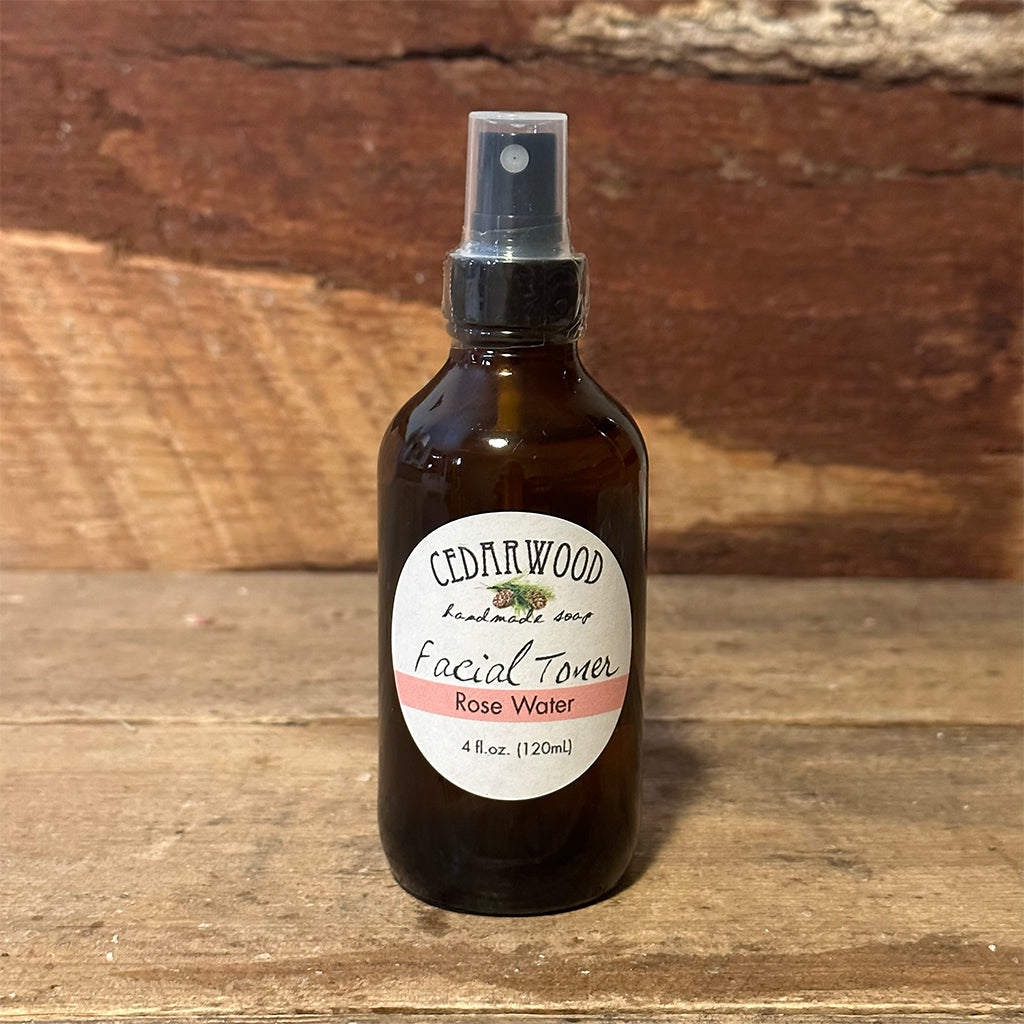Creating Rose Hydrosol to make Rose Water Facial Toner

Rose water has been used for its beneficial properties since the time of the Egyptians. There is even speculation that Cleopatra herself used rose water! Many of you know that I have a beautiful old-fashioned rose bush that produces bountiful blooms every summer. I use those petals and rose hips to make our Rose Petals soap and Rose Hip with Shea butter soap. 
As I began thinking about a new product (or products) that would fit well into our Cedarwood Soap family I thought of face toner. I am a huge fan of toner and use it daily. Rose water is one of the most beneficial ingredients to use in a toner. It is anti-inflammatory, antibacterial and has antioxidant properties. It tones your skin and cleans your pores. To retain the wonderful qualities of the rose water in its purest form it needs to be processed using a method called steam distillation. This process creates a hydrosol. Sometimes called “flower water,” hydrosol comes from the Latin words hydro and sol meaning “water solution.” Hydrosols contain trace amounts of essential oil but have a much more subtle scent. The steam-distillation process also prolongs the shelf life of the toner (6-9 months). And since this rose hydrosol is made from the petals of my rose bush it is completely organic.
I did some research to learn about the steam distillation process and, ironically, I remembered seeing an episode of Alton Brown’s Good Eats several years ago in which he distilled rose water to use in backlava. I was familiar with the basic concept and I thought it would be fun to try something new. I gathered my soapmaking pot, a small glass bowl, a brick (Yes, a brick. We’ll talk about that in a minute), and some rose petals I had dried last Fall.
Back to the brick. I wrapped the brick in aluminum foil to keep the rose petals clean, placed it in the bottom of my soapmaking pot. Next, I put enough rose petals in the pot to come up level with the top of the brick. With no clue how much rose water would actually be produced by this process, I poured enough distilled water to come almost to the top of the brick. I then placed my small glass bowl on top of the brick (This is where the rose water will collect. In the bowl, not the brick. Lol). Finally, I placed the inverted lid on top of the pot and filled it with ice. (I put foil around the rim of the pot because, when the lid was inverted, it didn’t create a tight seal.)

The concept is that, as the water boils, the steam will rise, hit the cold lid and the hydrosol will drip into the glass bowl. I brought the water to a boil, crossed my fingers and waited. As the ice melted, I scooped out the water and added more ice.

After about 30 minutes I couldn’t wait any longer. I peeked into the pot and there was water in the small bowl! Not nearly as much as I needed and there was still plenty of water in the pot that hadn’t boiled off yet. So I put the lid back on, continued adding more ice to the lid and waited for another 30 minutes. After a full hour I looked again and that little bowl was almost FULL! I was ecstatic.
I carefully removed the water-filled lid and let the entire thing cool. The last thing I needed was to spill the liquid gold in that little bowl! I knew I needed to have at least 16 oz of rose hydrosol to make eight bottles of Rose Water toner. Once everything was cool enough to handle, I took the small glass bowl out and poured it into a clean measuring cup. Guess how much rose water I had? Exactly 16 oz on the dot!! I couldn’t have done that if I tried! 
The next steps in the process were fairly easy compared to the steam distillation. I combined the rose hydrosol with the other ingredients: witch hazel, aloe vera liquid, and rose absolute oil. Witch hazel contains antioxidants and is anti-inflammatory. Rose absolute oil is anti-inflammatory and is an astringent. It is great for dry, itchy skin. Aloe vera liquid contains beneficial vitamins, minerals, sugars, enzymes, salicylic acids, and amino acids. Mucopolysaccharides, found in the aloe plant, help retain moisture in the skin.
Each Rose Water Face Toner comes in a safety-sealed 4 fl.oz. amber glass bottle.
Now that you’ve learned all about the process of steam distillation, get on over to our website so you can try some for yourself. Get yours today by clicking here. We also have a lavender facial toner made with distilled lavender water, witch hazel and lavender essential oil. You can buy those here.
Check out all of our other wonderful, handmade, all-natural, vegan soaps, lip balms, lotion bars and much more by clicking here.
(Disclaimer: Regulations set forth by the FDA prohibit bath and body companies from making health-related claims about beauty products. I am not a medical or healthcare professional and do not claim that the use of my products may have a positive effect on pre-existing physical and/or mental health conditions. The information in my listings pertains to the properties of specific ingredients used in the product.)

Leave a comment